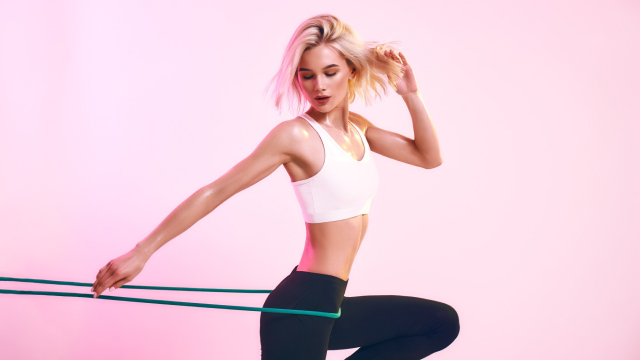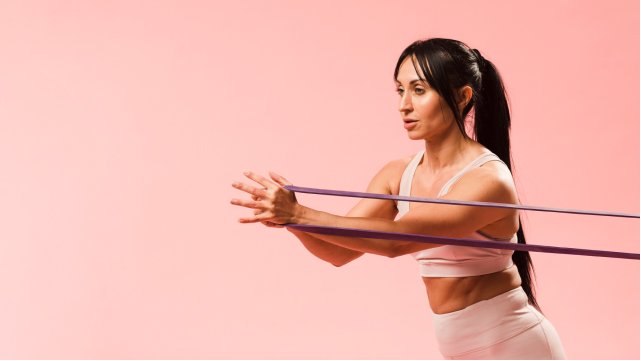Introduction
The resistance band is an excellent addition to your workout routine. They’re portable and easy to store, so you can take them with you wherever you go. Plus, they’re inexpensive–you can get a set for less than $20!
Resistance bands offer several benefits over free weights:
- They provide constant resistance throughout the entire range of motion (ROM) of an exercise. This allows for more complete muscle activation and greater gains in strength and endurance than traditional weightlifting alone.
- Resistance band exercises target multiple muscle groups at once, making them ideal for full-body workouts that don’t require much time or equipment.
Exercise 1: Squats
How to do the exercise:
- Stand with your feet shoulder-width apart and hold one end of a resistance band in each hand.
- Place your hands on your hips, then slowly bend both knees until they’re at about 90 degrees (or as far as you can go without rounding your back).
- Pause for a second, then return to starting position and repeat 10 times.
Benefits:
This move works all four major muscle groups in your legs, the hamstrings, quadriceps, glutes, and calves–and helps build strength in those areas so that they’re less likely to give out during other exercises like squats or lunges. It also strengthens your core muscles by forcing them to support the weight of your body as well as any extra pounds from carrying around extra fat!
Exercise 2: Lunges
- Lunges are a great way to work your lower body and core. To do this exercise:
- Hold a resistance band at each end and step forward with one foot into a lunge position.
- Lower yourself until both knees form 90-degree angles.
- Then return to the standing position by stepping back with the other leg.
- Repeat for 10 repetitions on each side of your body for 1 set; perform 2 more sets total for 3 sets total.
Variations:
To increase the intensity, hold two bands together and perform lunges with both legs at once; use heavier resistance bands if needed or desired (you can also use dumbbells instead).
Benefits:
Lunges help strengthen muscles in the glutes (butt), hamstrings (backs of thighs), quadriceps (fronts of thighs), calves, and core–all while improving balance!
Exercise 3: Push-Ups
Push-ups are one of the best bodyweight exercises you can do. They’re also one of the most versatile and effective ways to build upper body strength, especially in your chest and triceps.
The exercise:
- Get into a plank position with your hands directly under your shoulders.
- Then lower yourself until your chest touches the ground (or as close as possible).
- Push back up, straightening out your arms completely at the top of each rep.
- That’s one!
Variations:
If regular push-ups are too difficult for you right now, try doing them on an inclined surface such as a bench or chair seat instead of flat ground–it’ll make it easier for you to get down low without having to bend over so much. Or if they’re still too hard after that change has been made, try doing modified versions where only one arm is used at a time instead of both; this will help distribute some weight off each limb so they don’t feel quite so much pressure during movement patterns like these ones tend to cause when done correctly!
Exercise 4: Pull-Ups
This exercise is one of the most effective ways to work your back muscles. To do it:
- Place the band around both legs and hold on to each end of the band with both hands.
- Then step away from a sturdy object such as a chair or wall so that there’s enough room for you to fully extend your arms straight out in front of you.
- Next, bend forward at the waist until your torso is parallel to the floor (or as close as possible).
- Finally, pull yourself back up into an upright position by contracting those same muscles used when doing pull-ups at home, the biceps!
If this version feels too easy for you, try adding weight onto one side by holding dumbbells in each hand while performing all steps listed above except for step 5 (pulling yourself up).
Exercise 5: Tricep Dips
Tricep dips are a great exercise to build strength in your triceps and shoulders. If you don’t have a chair or bench, try doing this move with your feet on a step or stool.
- Stand with your feet hip-width apart, holding one end of the band in each hand.
- Bend at the knees and lower yourself until your arms are straight but not locked out (the position should be similar to when you’re about to do a pushup).
- Your elbows should be bent 90 degrees so that they’re pointing toward the floor as well as slightly behind you. Keep them close together throughout the movement so that they form an “L” shape with your torso when viewed from above.
- Gently press down through both arms until they’re almost straightened again; then return slowly back up until they’re fully extended.
- Repeat for 10 reps per set
Exercise 6: Bicep Curls
This exercise is a great way to work the biceps and shoulders.
To do it:
- Stand with your feet shoulder-width apart and hold onto both ends of your resistance band with your arms extended in front of you at chest height.
- Bend at the waist so that your torso is almost parallel to the floor.
- Then raise one arm up toward the ceiling as high as possible without letting go of either end of the band or allowing it to touch anything else (you may need someone’s help holding onto this).
- Lower slowly back down until fully extended again before repeating on the other side.
- Repeat 10 times per set on each side for three sets total per day;
Try not to overdo this one!
Exercise 7: Shoulder Press
To do the shoulder press, you’ll need to:
- Loop the band around your feet and hold both ends in one hand.
- Then, extend your arm straight out in front of you so that it’s parallel to the floor.
- Next, bend at the elbow and lower down until your upper arm is parallel to the floor (or slightly higher). Press back up into starting position as quickly as possible.
- Repeat this exercise for 10-15 reps on each side (20 total).
You can also increase the difficulty by holding onto a heavier resistance band or using two bands at once instead of one!
The shoulder press works several muscles in addition to those listed above: triceps, chest, and core muscles like obliques and rectus abdominal all get worked while doing this move!
Exercise 8: Abdominal Crunches
The abdominal crunch is a basic exercise that can be done with or without the band. To perform this exercise:
- lie on your back with knees bent and feet flat on the floor.
- Place one end of the resistance band around both feet and hold onto the other end with both hands.
- Raise shoulders off the ground by contracting abs, then lower back down slowly while exhaling through pursed lips (this helps activate abdominal muscles).
Variations:
If you have a limited range of motion in your neck or shoulders, try placing a pillow under your head as shown above instead of using resistance bands!
Benefits:
This move works multiple muscle groups including obliques (side abs), rectus abdominal (front), and transversus abdominis (back). The added resistance provided by using bands allows us to target all areas more effectively than without them!
Exercise 9: Back Extensions
This exercise is a great way to work your back and glutes. It’s also a good alternative if you have access to a gym, but not the equipment needed for pull-ups or lat pulldowns (like me).
To do this exercise:
- Stand on one end of the band with both feet together and hold onto both ends in front of your chest with straight arms
- Bend forward at the hips until your upper body is parallel to the floor, keeping your knees slightly bent throughout.
Exercise 10: Glute Bridges
Glute bridges are a great exercise for your glutes and hamstrings. To do this exercise:
- Lie on your back with knees bent and feet flat on the floor.
- Lift up off of the floor while keeping your lower back in contact with it at all times (this is important!).
- Hold for 1-2 seconds before lowering yourself back down slowly to complete one rep.
Variations:
You can make this harder by placing a resistance band around both ankles or placing them under something heavy like a couch or chair so that there is extra weight pulling down on them during each rep of the bridge movement. This will help activate even more muscles in those areas!
Benefits:
Building strength in these muscles will help prevent injury when doing other types of cardio activities such as running or cycling because they’ll be able to support more weight without straining themselves too much during activity time periods such as high intensity interval training (HIIT).
Conclusion
You can use resistance bands for a variety of exercises, and they’re great for beginners because they’re easy to use and won’t put too much stress on your joints. If you’re someone who has been working out regularly but wants to add some variety into their routine, resistance bands might be just what you need.
Researches
- “Effects of elastic resistance training on muscle strength and functional performance in healthy adults: a systematic review” Link: https://pubmed.ncbi.nlm.nih.gov/31041785/
- “The effects of resistance band training on muscle strength, endurance, and functional fitness in older adults” Link: https://www.ncbi.nlm.nih.gov/pmc/articles/PMC4715254/
- “Resistance band training improves strength, power, and functional performance in community-dwelling older adults” Link: https://www.ncbi.nlm.nih.gov/pmc/articles/PMC6335959/
- “Comparison of elastic band and isotonic resistance exercises in elderly women” Link: https://www.ncbi.nlm.nih.gov/pmc/articles/PMC4523473/
- “The effects of resistance band training on flexibility and balance among older adults” Link: https://www.ncbi.nlm.nih.gov/pmc/articles/PMC6281417/
These studies provide evidence for the benefits of resistance band exercises, particularly for older adults or those looking to improve their functional fitness.

